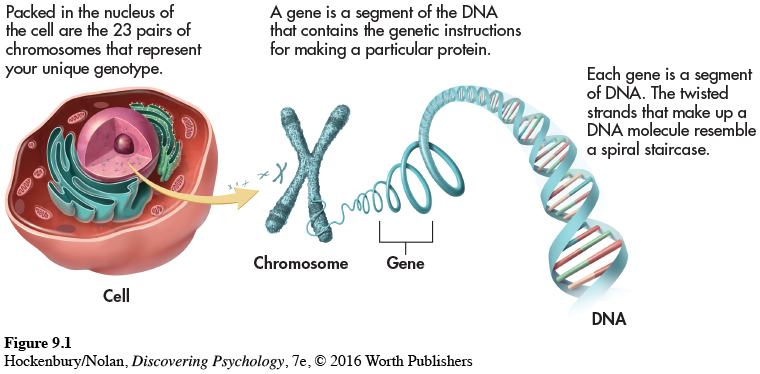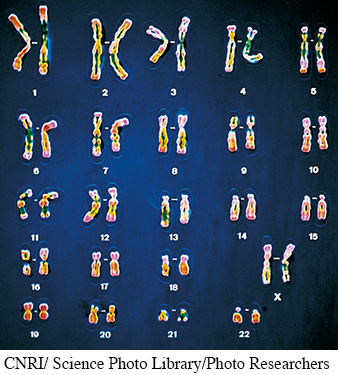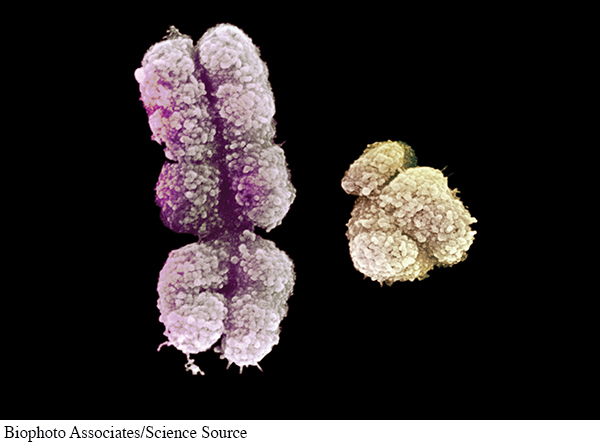Genetic Contributions to Development
KEY THEME
Your genotype consists of the chromosomes inherited from your biological parents, but your phenotype—
KEY QUESTIONS
What are DNA, chromosomes, and genes?
What role does the environment play in the relationship between genotype and phenotype?
What is epigenetics?
You began your life as a zygote, a single cell no larger than the period at the end of this sentence. Packed in that tiny cell was the unique set of genetic instructions that you inherited from your biological parents. Today, that same set of genetic information is found in the nucleus of nearly every cell of your body.
What form do these genetic data take? The genetic data you inherited from your biological parents is encoded in the chemical structure of the chromosomes that are found in the cell nucleus. As depicted in Figure 9.1, each chromosome is a long, thread-

Each of your chromosomes has thousands of DNA segments, called genes, that are strung like beads along its length. Each gene is a unit of DNA code for making a particular protein molecule. Interestingly, genes actually make up less than 2 percent of human DNA (Human Genome Project, 2008). Determining the functions of the rest of the DNA is an active area of investigation. This DNA was once referred to as “junk DNA,” but most researchers today believe that it is involved in regulating gene functioning (McDaniell & others, 2010; Parker & others, 2009).
What do genes do? In a nutshell, genes direct the manufacture of proteins. Proteins are used in virtually all of your body’s functions—
Your Unique Genotype

At fertilization, your biological mother’s egg cell and your biological father’s sperm cell each contributed 23 chromosomes. This set of 23 chromosome pairs represents your unique genotype, or genetic makeup. With the exception of the reproductive cells (sperm or eggs), every cell in your body contains a complete, identical copy of your genotype.
In recent years, scientists mapped out the human genome—the complete set of DNA in the human organism (Lander & others, 2001; Venter & others, 2001). One unexpected discovery was that the complete human genome contains only about 20,000 to 25,000 protein-
Although all humans have the same basic set of genes, these genes can come in different versions, called alleles. As a general rule, your genotype contains two copies of each gene—
The best-
Unlike freckles, most characteristics involve the interaction of multiple genes (Buchanan & others, 2009). For these characteristics, each gene contributes only a small amount of influence to a particular characteristic.
From Genotype to Phenotype
MYTH SCIENCE
Is it true that the genes you inherit provide an unchanging “blueprint” that determines your physical characteristics, abilities, and personality traits?
While the term genotype refers to an organism’s unique genetic makeup, the term phenotype refers to the characteristics that are actually observed in an organism. At one time, the genotype was commonly described as a “genetic blueprint,” which implied that the genotype was a fixed, master plan, like an architectural blueprint. It was thought that a person’s inherited genotype directed and controlled virtually all aspects of development as it unfolded over the lifespan (Dar-

The first problem with the genotype-
Second, environmental factors influence the phenotype you display. For example, even if your genotype contains a copy of the dominant “freckles” gene, you will not develop freckles unless the expression of that dominant gene is triggered by a specific environmental factor: sunlight. On the other hand, if you carry two recessive “no freckles” genes, you won’t develop freckles no matter how much time you spend in the sunlight.
Most of the genes in each person are dormant. Experience affects which genes are turned on (and off), and when. Thus, the environment participates in sculpting expression of the genome.
—Adele Diamond (2009)
Here’s the important point: Different genotypes react differently to environmental factors (Masterpasqua, 2009). Thus, psychologists and other scientists often speak of genetic predispositions to develop in a particular way (Champagne & Mashoodh, 2009). In other words, people with a particular genetic configuration will be more or less sensitive to particular environmental factors. For example, think of people you know who sunburn easily, such as redheads or people with very fair skin. Their genotype is especially sensitive to the effects of ultraviolet light. One person’s freckle factory is another person’s light tan—
THE NEW SCIENCE OF EPIGENETICS
Each of us started life as a single-
The dramatic differences among the size, shape, and function of cells are due to which genes are “expressed,” or activated to participate in protein production. Put simply, cells develop differently because different genes are activated at different times. Some genes are active for just a few hours, others for a lifetime. Many genes are never expressed. For example, humans carry all of the genes to develop a tail, but we don’t develop a tail because those genes are never activated.
The old “nature versus nurture” debate has long since receded into scientific irrelevance. Instead, the frontier lies in understanding the mechanisms by which environmental factors—
—Steven E. Hyman (2009)
What triggers a gene to activate? Gene expression can be triggered by the activity of other genes, internal chemical changes, or by external environmental factors, such as sunlight in our earlier freckles example. Thus, gene expression is flexible, responsive to both internal and external factors (Meaney, 2010; Szyf, 2013).
Scientists have only recently begun to understand the processes that regulate gene expression. This new field is called epigenetics—the study of the mechanisms that control gene expression and its effects on behavior and health (Meaney, 2010; Zhang & Meaney, 2010). For any given cell, it’s the epigenetic “settings” that determine whether it will become a skin cell, a nerve cell, or a heart muscle cell. Thus, epigenetics investigates how gene activity is regulated within a cell, such as identifying the signals that switch genes to “on” or “off.”
To help illustrate epigenetic influences, consider identical twins, who develop from a single zygote. Each twin inherits exactly the same set of genes. Yet, as twins develop, differences in physical and psychological characteristics become evident. These differences are due to epigenetic changes—
Epigenetic research is providing new insights into how the environment affects gene expression and the phenotype (Champagne, 2010; Szyf & Bick, 2013). For example, consider the groundbreaking series of experiments conducted by teams led by Canadian neuroscientist Michael Meaney (2001, 2010). He showed that newborn rats that were genetically predisposed to be skittish, nervous, and high-
The important point is that although the rats’ DNA did not change, the chemical tags that control gene expression did change. The rats’ upbringing set in motion a cascade of epigenetic changes that changed their brain chemistry and literally “reprogrammed” their future behavior (see Hyman, 2009; Sapolsky, 2004). Surprisingly, the influence of their upbringing extended to the next generation: The calm, stress-
Psychologists and other scientists are beginning to identify epigenetic influences in humans. One area of active study is the impact of early stress (see Champagne, 2010; Jensen, 2014). Would childhood stress or adversity produce a recognizable pattern of epigenetic changes in adult humans, as it does in adult rats? One study found that suicide victims who had been abused as children had distinct epigenetic marks in brain tissue that were not found in the brains of control subjects or in suicide victims who had not been abused as children (McGowan & others, 2009). The pattern of epigenetic marks was consistent with that shown in studies of rat pups who had experienced early stress, such as being separated from their mothers (Hyman, 2009). The research suggested that early childhood adversity had created long-
Interactions among genes, and between the genotype and environmental influences, are two critical factors in the relationship between genotype and phenotype. Beyond these factors, genes can also mutate, or spontaneously change, from one generation to the next. Further, DNA itself can be damaged by environmental factors, such as exposure to ultraviolet light, radiation, or chemical toxins. Just as a typo in a recipe can ruin a favorite dish, errors in the genetic code can disrupt the production of the correct proteins and lead to birth defects or genetic disorders.